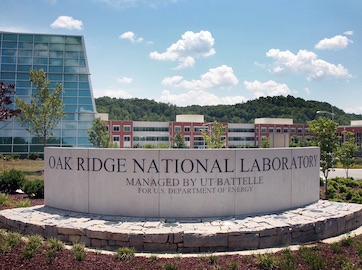Filter Results
Related Organization
- Biological and Environmental Systems Science Directorate (9)
- Computing and Computational Sciences Directorate (1)
- Energy Science and Technology Directorate (20)
- Fusion and Fission Energy and Science Directorate (2)
- Isotope Science and Enrichment Directorate (1)
- Neutron Sciences Directorate (2)
- User Facilities (2)
- (-) Physical Sciences Directorate (30)
Researcher
- Tomonori Saito
- Radu Custelcean
- Ramesh Bhave
- Syed Islam
- Costas Tsouris
- Jeffrey Einkauf
- Diana E Hun
- Gyoung Gug Jang
- Jeff Foster
- Mary Danielson
- Santa Jansone-Popova
- Shailesh Dangwal
- Shannon M Mahurin
- Sheng Dai
- Zhenzhen Yang
- Alexei P Sokolov
- Alexey Serov
- Anisur Rahman
- Benjamin L Doughty
- Bruce Moyer
- Corson Cramer
- Craig A Bridges
- Diana Stamberga
- Felipe Polo Garzon
- Gabriel Veith
- Gs Jung
- Ilja Popovs
- Jennifer M Pyles
- Jong K Keum
- Jun Qu
- Jun Yang
- Junyan Zhang
- Karen Cortes Guzman
- Kuma Sumathipala
- Laetitia H Delmau
- Lawrence {Larry} M Anovitz
- Li-Qi Qiu
- Luke Sadergaski
- Md Faizul Islam
- Mengjia Tang
- Mina Yoon
- Natasha Ghezawi
- Nick Galan
- Nikki Thiele
- Subhamay Pramanik
- Tao Hong
- Xiang Lyu
- Zoriana Demchuk

PET is used in many commercial products, but only a fraction is mechanically recycled, and even less is chemically recycled.

Developed a novel energy efficient, cost-effective, environmentally friendly process for separation of lithium from end-of-life lithium-ion batteries.

The technologies provides for regeneration of anion-exchange resin.
Contact
To learn more about this technology, email partnerships@ornl.gov or call 865-574-1051.

This work presents a novel method for upcycling polyethylene terephthalate (PET) waste into sustainable vitrimer materials. By combining bio-based crosslinkers with our PET-based macromonomer, we developed dynamically bonded plastics that are renewably sourced.

Ruthenium is recovered from used nuclear fuel in an oxidizing environment by depositing the volatile RuO4 species onto a polymeric substrate.

A novel strategy was developed to solve the limitations of the current sorbent systems in CO2 chemisorption in terms of energy consumption in CO2 release and improved CO2 uptake capacity.

This invention describes a new class of amphiphilic chelators (extractants) that can selectively separate large, light rare earth elements from heavy, small rare earth elements in solvent extraction schemes.

This invention focuses on improving the ceramic yield of preceramic polymers by tuning the crosslinking process that occurs during vat photopolymerization (VP).

The increasing demand for high-purity lanthanides, essential for advanced technologies such as electronics, renewable energy, and medical applications, presents a significant challenge due to their similar chemical properties.

With the ever-increasing problem of plastic waste, several avenues to decrease plastic use and manage waste introduced by disposable plastic products have arisen.

